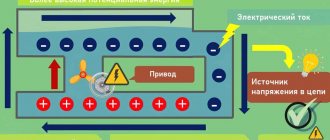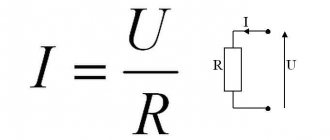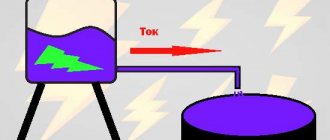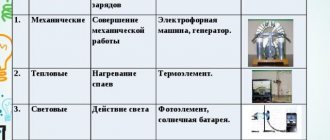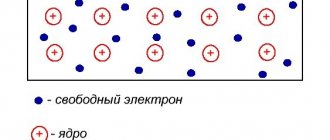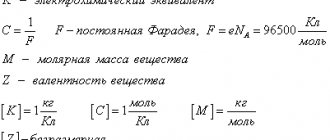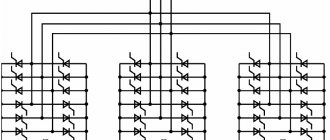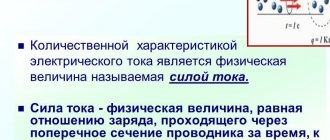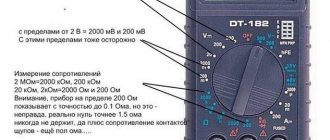4.7
Average rating: 4.7
Total ratings received: 173.
4.7
Average rating: 4.7
Total ratings received: 173.
Electric current in physics is the coordinated (ordered, unidirectional) movement of electrically charged elementary particles (electrons, protons, ions) or charged macroscopic particles (for example, raindrops during a thunderstorm). In substances in different states of aggregation (solid, liquid, gas), current can be formed from a different set of charged particles. Let us consider the mechanism of formation of electric current in metals.
Free electrons in metals
Substances related to metals can be in both solid and liquid states (mercury, gallium, cesium, etc.). Moreover, they are all conductors of electric current. Solids have the structure of a rigid crystal lattice, in the nodes of which positively charged ions “sit”, making small fluctuations around the equilibrium point. In the volume of a crystal there is always a large number of free electrons that have escaped from the orbits of atoms as a result of mechanical collisions or exposure to radiation.
Rice. 1. The mechanism of electric current in metals.
This electron “cloud” moves randomly, chaotically, until an electric field is applied to the metal. The electric field E created by an external source (battery, accumulator) acts on charge q with force F:
$$ F = q*E $$
Under the influence of this force, electrons acquire acceleration in one direction and, thus, an electric current appears in the circuit.
Numerous observations have shown that when an electric current passes, the mass of conductors and their chemical composition do not change. This leads to the conclusion that metal ions, which make up the bulk of the substance, do not take part in the transfer of electric charge.
Gold
Gold is a good electrical conductor and does not oxidize like other metals when exposed to air. For example, steel or copper can oxidize (corrode) when exposed to oxygen for long periods of time. Gold is one of the most expensive metals and is only used for certain materials, such as circuit board components or small electrical connectors. Some materials may have gold plating as a conductor.
The experience of Mandelstam and Papaleksi
The electronic nature of current in metal was first experimentally proven by Russian physicists Mandelstam and Papaleksi in 1913. In order to find out which particles create electric current in metals, they - without connecting an external source - recorded the current in a coil of metal wire, which was first strongly spun around its own axis, and then abruptly stopped. Since the electron has mass, it must obey the law of inertia. Therefore, at the moment of stopping, the lattice atoms will remain in place, and free electrons, by inertia, will continue to move in the same direction for some time. That is, an electric current must appear in the circuit. Experiments confirmed this assumption - after the coil stopped, the researchers recorded an inrush of current in the circuit.
Rice. 2. The experience of Mandelstam and Papaleksi.
This experiment was repeated in 1916 by the Americans Stewart and Tolman. They managed to increase the accuracy of measurements and obtain the ratio of the electron charge ee to the value of the electron mass me:
$$ {e_e \over m_e } = 1.8*10^{11} C/kg $$
This fundamental result coincided with data obtained from other experiments based on measurements of other parameters. This value was first measured in 1897 by the Englishman Joseph Thomson from the deflection of an electron beam depending on the electric field strength.
Recycling after use
Despite the long service life of the cables (from 15 to 30 years), they all need to be replaced after this period has expired. After this, the cables must be disposed of and recycled. Searching for wires and delivering them to scrap metal collection points allows us to partially solve the problem of obtaining primary raw materials. Collection points accept scrap:
- household;
- control;
- power;
- special cables.
The price per kilogram of scrap is determined:
- The quality of supplied raw materials.
- The percentage of a particular metal.
- Purity – the amount of contaminants and oxides.
- The integrity of the sheath, as well as the complexity of further processing of cable scrap.
- Volume of recyclable materials - the more cable scrap is handed over, the higher the price per kilogram.
Speed of propagation of electric current
The speed of propagation of the electric field in a metal is close to the speed of light in a vacuum, which is 300,000 km/s. But this does not mean that electrons inside the substance move at the same speed. For a conductor with a cross-sectional area S = 1 mm2 at a current strength I = 1 A, the speed of the ordered movement of electrons is v = 6 * 10-5 m/s. That is, in one second, electrons in a conductor, due to their ordered movement, travel only 0.06 mm.
Such low speeds of electron movement in conductors do not lead to a delay in turning on electric lamps, turning on household appliances, etc., since when voltage is applied, an electric field propagates along the wires at the speed of light. This speed is so high that it allows free electrons to move almost instantly in all conductors of an electrical circuit.
Electrical conductivity of wood
The ability to conduct electric current characterizes the electrical resistance of wood. In general, the total resistance of a wood sample placed between two electrodes is determined as the result of two resistances: volumetric and surface. Volume resistance numerically characterizes the obstacle to the passage of current through the thickness of the sample, and surface resistance determines the obstacle to the passage of current along the surface of the sample. Indicators of electrical resistance are volumetric and surface resistivity. The first of these indicators has the dimension ohm per centimeter (ohm x cm) and is numerically equal to the resistance when current passes through two opposite faces of a cube measuring 1X1X1 cm made of a given material (wood). The second indicator is measured in ohms and is numerically equal to the resistance of a square of any size on the surface of a wood sample when current is supplied to the electrodes delimiting two opposite sides of this square. Electrical conductivity depends on the type of wood and the direction of current movement. As an illustration of the order of magnitude of volumetric and surface resistance in Table. 22 shows some data.
Table 22. Comparative data on the specific volumetric and surface resistance of wood.
| Breed and direction | Humidity, % | Specific volume resistivity, ohm x cm | Specific surface resistance, ohm |
| Birch, along the grain | 8,2 | 4.2 x 1010 | 4.0 x 1011 |
| Birch, across the grain | 8,0 | 8.6 x 1011 | 2.8 x 1012 |
| Beech, along the grain | 9,2 | 1.7 x 109 | 9.4 x 1010 |
| Beech, across the grain | 8,3 | 1.4 x 1010 | 7.9 x 1010 |
To characterize electrical conductivity, volumetric resistivity is of greatest importance. Resistance is highly dependent on the moisture content of the wood. As the moisture content of wood increases, the resistance decreases. A particularly sharp decrease in resistance is observed with an increase in the content of bound moisture from an absolutely dry state to the hygroscopic limit. In this case, the volumetric resistivity decreases by millions of times. A further increase in humidity causes a drop in resistance only tenfold. This is illustrated by the data in Table. 24.
Table 23. Specific volumetric resistivity of wood in an absolutely dry state.
| Breed | Specific volume resistivity, ohm x cm | |
| across the grain | along the grain | |
| Pine | 2.3 x 1015 | 1.8 x 1015 |
| Spruce | 7.6 x 1016 | 3.8 x 1016 |
| Ash | 3.3 x 1016 | 3.8 x 1015 |
| Hornbeam | 8.0 x 1016 | 1.3 x 1015 |
| Maple | 6.6 x 1017 | 3.3 x 1017 |
| Birch | 5.1 x 1016 | 2.3 x 1016 |
| Alder | 1.0 x 1017 | 9.6 x 1015 |
| Linden | 1.5 x 1016 | 6.4 x 1015 |
| Aspen | 1.7 x 1016 | 8.0 x 1015 |
Table 24. Effect of humidity on the electrical resistance of wood.
| Breed | Specific volume resistivity (ohm x cm) across the grain at wood moisture content (%) | ||
| 22 | 100 | ||
| Cedar | 2.5 x 1014 | 2.7 x 106 | 1.8 x 105 |
| Larch | 8.6 x 1013 | 6.6 x 106 | 2.0 x 105 |
The surface resistance of wood also decreases significantly with increasing humidity. An increase in temperature leads to a decrease in the volumetric resistance of wood. Thus, the resistance of false sugi wood decreases by 2.5 times when the temperature rises from 22-23° to 44-45° C (about half), and the resistance of beech wood decreases by 3 times when the temperature rises from 20-21° to 50° C. At negative temperatures, the volumetric resistance of wood increases. The specific volumetric resistance along the fibers of birch samples with a humidity of 76% at a temperature of 0°C was 1.2 x 107 ohm cm, and when cooled to a temperature of -24°C it turned out to be equal to 1.02 x 108 ohm cm. Impregnation of wood with mineral antiseptics (for example , zinc chloride) reduces the resistivity, while impregnation with creosote has little effect on the electrical conductivity. The electrical conductivity of wood is of practical importance when it is used for communication poles, masts of high-voltage transmission lines, handles of power tools, etc. In addition, the design of electric moisture meters is based on the dependence of electrical conductivity on the moisture content of wood.
Application of the properties of electric current in metals
The physical properties of electric current are used in various areas of life:
- The ability of electric current to heat conductors is used for the manufacture of heating household and industrial appliances;
- A magnetic field arises around a wire carrying electric current, which made it possible to create electric motors, which are impossible to do without today;
- The transmission of electricity over various distances is carried out through the wires of power transmission lines (PTLs), through which electric current flows.
Rice. 3. Application of electric current.
Who is guilty?
In most cases, the power supply or operating organization itself bears responsibility for the condition of the power line. Since its employees constantly monitor branches overhanging power lines or their location in close proximity to them. After all, each line has a power line security zone protruding in both directions from the wires at a distance of 2 to 55 m, depending on the voltage level in it.
Figure 3: overhead line security zone
The power supply organization carries out constant inspections of the line to identify such threats, and if any are identified, they are obliged to remove the emergency tree or branches that threaten the wires.
If old trees are on the balance sheet of any organization, enterprise and electricity supplier simply did not have access or permission to cut them down, then the blame falls on this organization. The same can be said about urban electric transport, when the fall occurred on tram or trolleybus wires.
In addition, the circle of culprits may also include ordinary citizens who decided to cut down in the local area, carried out cutting in public places or along a line for the purpose of collecting firewood. This also includes private entrepreneurs and other legal entities who organized work without the appropriate permits and their actions led to the fall of a tree with subsequent breakage of a high-voltage wire or an interphase short circuit.
